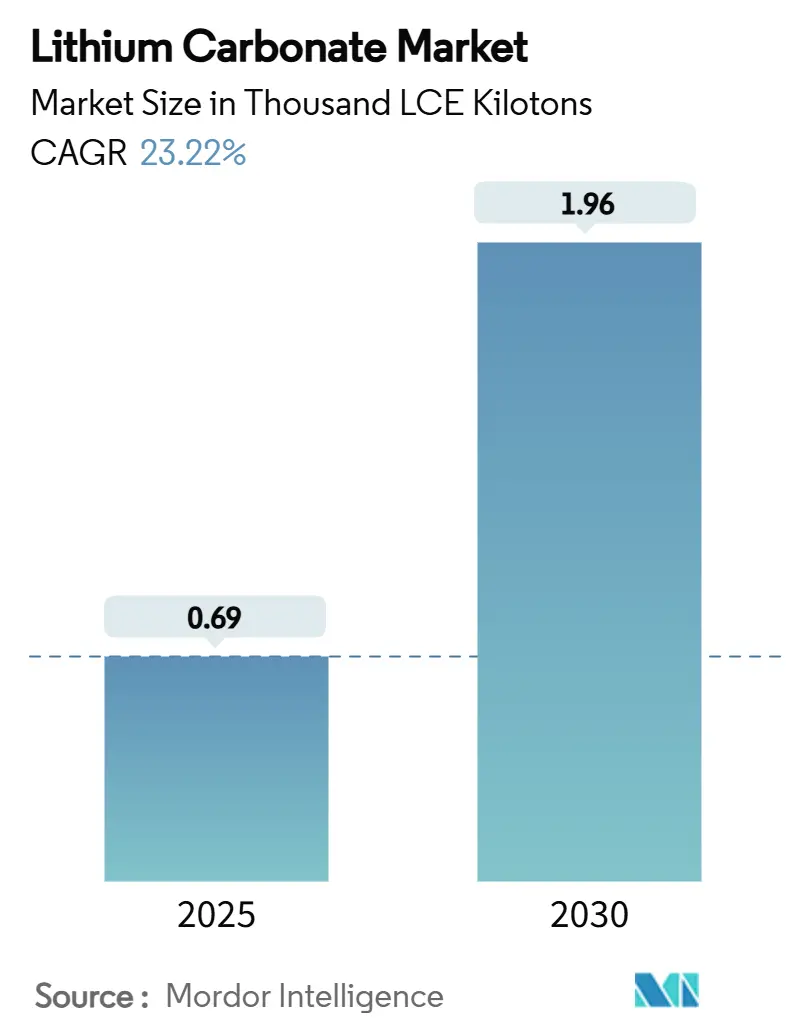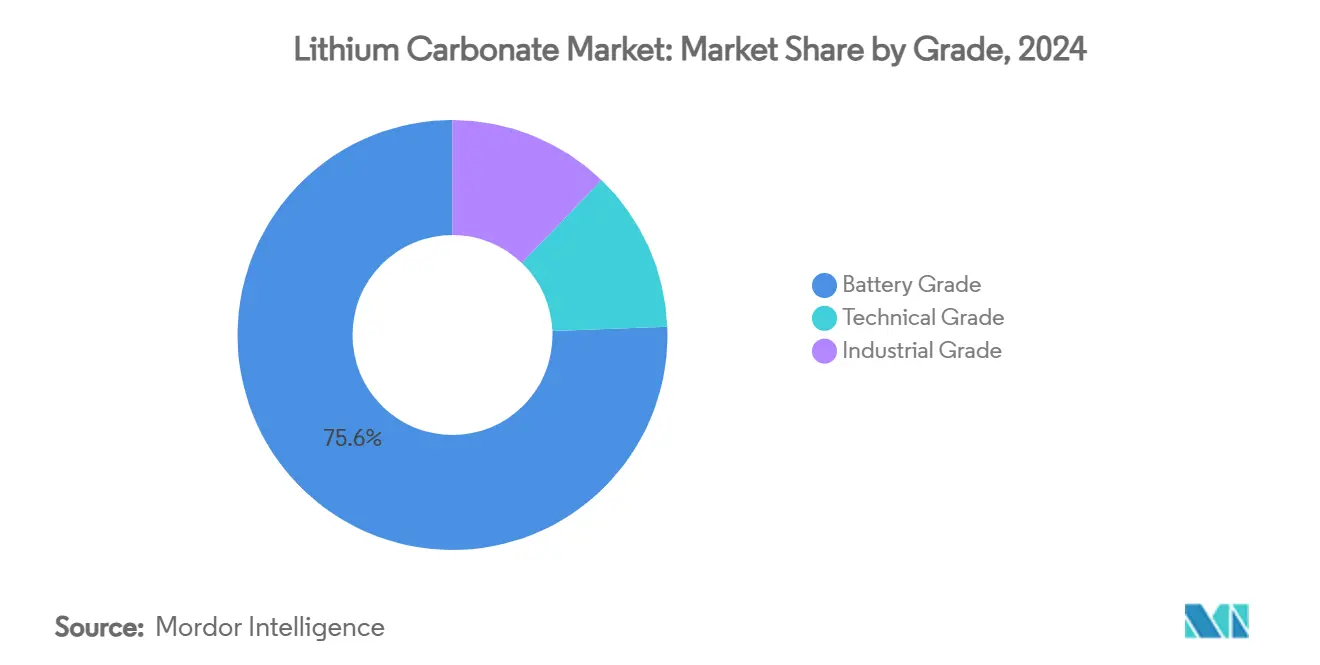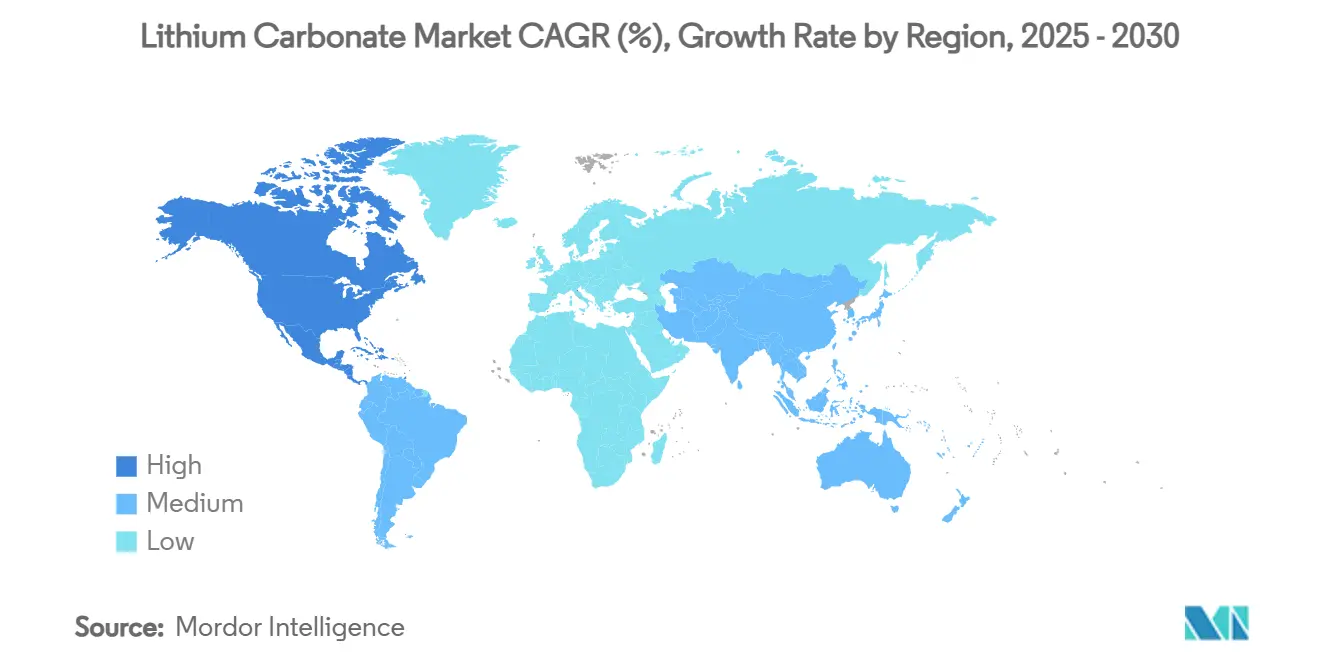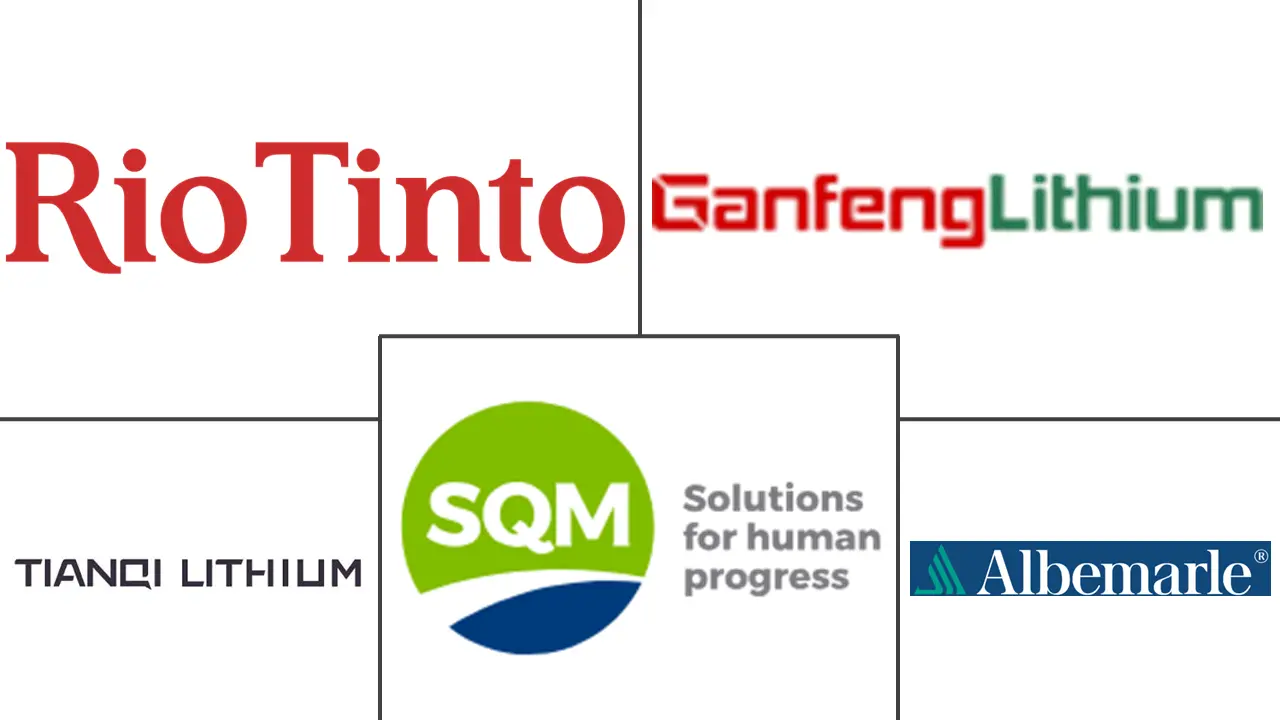Lithium Carbonate Market Size and Share

Lithium Carbonate Market Analysis by Mordor Intelligence
The Lithium Carbonate Market size is estimated at 0.69 thousand LCE kilotons in 2025, and is expected to reach 1.96 thousand LCE kilotons by 2030, at a CAGR of 23.22% during the forecast period (2025-2030). Rapid electric-vehicle adoption, grid-scale battery roll-outs, and the commercialization of Direct Lithium Extraction (DLE) technologies underpin this expansion. The dominant Asia-Pacific production base benefits from an integrated battery supply chain, while policy-driven supply-chain localization in North America and Europe is reshaping trade flows. Battery-grade material continues to capture the bulk of revenue, yet diversification into glass, ceramics, and pharmaceutical uses is adding volume resilience. On the supply side, brine resources still lead, but fast-growing spodumene projects and DLE plants are diluting regional concentration risks.
Key Report Takeaways
- By grade, battery-grade lithium carbonate led with 75.62% revenue share in 2024; it is forecast to expand at a 24.54% CAGR to 2030.
- By source, brine operations accounted for 65.12% of the lithium carbonate market share in 2024, while spodumene extraction is projected to grow at a 23.86% CAGR through 2030.
- By application, Li-ion batteries held an 89.96% share of the lithium carbonate market size in 2024 and are advancing at a 24.27% CAGR to 2030.
- By end-use industry, the automotive sector captured 70.54% of the lithium carbonate market share in 2024; energy-storage systems are set to record the highest CAGR of 25.41% during 2025-2030.
- By geography, Asia-Pacific commanded 79.03% of 2024 volume; North America is forecast to grow the fastest at 28.73% CAGR to 2030.
Global Lithium Carbonate Market Trends and Insights
Drivers Impact Analysis
| Driver | (~) % Impact on CAGR Forecast | Geographic Relevance | Impact Timeline |
|---|---|---|---|
| Surging EV & energy-storage Li-ion battery demand | +5.20% | Global, with concentration in China, North America, Europe | Medium term (2-4 years) |
| Investments in glass & ceramics capacity in Asia | +4.80% | Asia-Pacific core, spill-over to North America | Long term (≥ 4 years) |
| Policy incentives accelerating battery-raw-material localisation | +3.10% | North America & EU, with secondary impact in APAC | Short term (≤ 2 years) |
| Deployment of sodium-lithium hybrid stationary-storage systems | +2.70% | China primary, expanding to APAC and global markets | Medium term (2-4 years) |
| Commercialisation of Direct Lithium Extraction (DLE) technologies | +1.90% | Global, with early adoption in North America and South America | Long term (≥ 4 years) |
| Source: Mordor Intelligence | |||
Surging EV & Energy-Storage Li-ion Battery Demand
Electric-vehicle makers sourced 70.54% of total lithium carbonate in 2024, with Tesla and Yahua formalising multi-year contracts to secure upstream feedstock. Grid-level deployments are scaling even faster; Canadian Solar reported a 91 GWh e-STORAGE pipeline and expects 7–9 GWh shipments in 2025[1]Canadian Solar, “Q1 2025 Results,” investors.canadiansolar.com . Sodium-lithium hybrid stations that went live in China in May 2025 lower pure-lithium intensity yet sustain aggregate demand. Automotive and stationary needs therefore compound, creating persistent pressure on the lithium carbonate market. Battery manufacturers are also segmenting specifications by application, which allows producers to optimise grade mix and capture price premiums.
Investments in Glass & Ceramics Capacity in Asia
Specialty-glass producers such as SCHOTT are integrating lithium compounds to enhance optical clarity and thermal performance for electronics and architectural façades. Albemarle has expanded pharmaceutical-grade output, indicating new high-purity niches at premium margins. Dental materials research confirms superior biocompatibility of lithium-silicate glass ceramics, stimulating broader adoption in restorative dentistry. Parallel R&D shows lithium carbonate can improve cement strength, opening a latent construction channel that hedges battery-cycle risk. These developments collectively broaden the lithium carbonate market beyond mobility.
Policy Incentives Accelerating Battery-Raw-Material Localisation
The United States Inflation Reduction Act affords tax credits that tilt economics in favour of domestic lithium processing. General Motors’ joint venture with Lithium Americas exemplifies OEM-driven upstream deals, while MP Materials underscores the national-security logic of integrated supply chains. Europe mirrors this stance, triggering a pipeline of mid-stream plants aimed at compliance with carbon-border tariffs. The resulting localisation premium supports higher-cost DLE projects and hard-rock mines, fueling the lithium carbonate market in regions previously considered marginal.
Deployment of Sodium-Lithium Hybrid Stationary-Storage Systems
China’s first large-scale sodium-lithium hybrid grid facility validates dual-chemistry architectures that cut material costs without sacrificing power capability. These systems combine sodium for bulk energy with lithium for peak response, optimising capex per kWh. Weight and footprint constraints are minimal for fixed installations, making hybrids ideal for renewable-integration mandates. Global utilities monitoring early results are likely to replicate the model, ensuring lithium carbonate demand remains tied to system-level performance metrics rather than pure energy density.
Restraints Impact Analysis
| Restraint | (~) % Impact on CAGR Forecast | Geographic Relevance | Impact Timeline |
|---|---|---|---|
| Limited economically-viable deposits & extraction constraints | -2.80% | Global, with concentration in South America and Australia | Long term (≥ 4 years) |
| Extreme price volatility impacting long-term contracts | -1.40% | Global, with particular impact on North America and Europe | Short term (≤ 2 years) |
| Water-usage & indigenous-rights conflicts at brine sites | -1.80% | South America core, with secondary impact in North America | Medium term (2-4 years) |
| Source: Mordor Intelligence | |||
Limited Economically-Viable Deposits & Extraction Constraints
Chile’s Atacama and Argentina’s lithium triangle host high-grade brines yet face mounting water-rights litigation and community pushback. Zangge’s enforced production halt in Qinghai after regulatory breaches demonstrates how swiftly output can be withdrawn. Hard-rock spodumene diversifies geography but raises energy-related processing costs, viable mainly during price peaks. Early-stage lepidolite and clay projects have yet to cross commercial thresholds, while recycled feedstock needs scale. The scarcity of economically recoverable battery-grade material therefore curbs the lithium carbonate market’s upside unless technological breakthroughs arrive.
Extreme Price Volatility Impacting Long-Term Contracts
Spot lithium carbonate swings exceeding 300% destabilise project financing. Piedmont Lithium highlighted that sub-USD 15,000-per-ton pricing stalled new investment in Q1 2025. Albemarle’s guidance range of USD 0.8 billion to USD 2.7 billion EBITDA depending on price underscores planning uncertainty. OEMs reluctant to lock into multi-year agreements risk supply gaps, while miners hesitate to sanction capital-intensive expansions without assured returns. Futures contracts and hedges partly offset risk but transfer volatility downstream, constraining long-range supply-demand synchrony in the lithium carbonate market.
Segment Analysis
By Grade: Battery Grade Dominance Drives Market Evolution
Battery-grade volumes represented 75.62% of overall consumption in 2024, reflecting alignment with cathode-quality thresholds demanded by EV and grid-storage manufacturers. The segment is forecast to grow 24.54% CAGR to 2030, reinforcing its centrality to the lithium carbonate market. Scale economies at conversion plants in China and emerging hubs in North America anchor cost leadership. Technical-grade material serves glass and ceramics where purity tolerance is wider, yet expanding Asian glass capacity translates to steady tonnage. Industrial-grade output occupies niches in aluminum fluxing and cement additives, benefiting from pilot studies that validate process efficiency gains.
Pharmaceutical-grade lithium carbonate commands premium pricing in mental-health therapeutics and exploratory Alzheimer’s protocols, delivering attractive margins for producers such as Albemarle[2]Albemarle, “Lithium Carbonate Pharmaceutical Grade,” albemarle.com . As healthcare trials expand, the lithium carbonate market size for medical applications could offset cyclical battery demand. The grade structure therefore blends high-volume battery demand with smaller yet lucrative specialty flows, enhancing producer revenue stability.

Note: Segment shares of all individual segments available upon report purchase
By Source: Brine Leadership Challenged by Spodumene Growth
Brine operations captured 65.12% of 2024 tonnage, leveraging naturally high lithium concentrations and solar evaporation economies. The lithium carbonate market share of brine is, however, gradually eroding as spodumene extraction records a 23.86% CAGR through 2030. Western Australia’s Greenbushes and Canada’s emerging Quebec corridor illustrate how hard-rock mines add geographic diversity and faster ramp-ups. DLE retrofits on brine assets further shift cost curves by compressing cycle times and cutting water use.
Clay and lepidolite initiatives remain pre-commercial but promise to boost the lithium carbonate market once processing bottlenecks ease. Recycled battery feedstock is nascent yet strategically significant; major cathode makers now trial closed-loop supply agreements that lower carbon footprints and import exposure. The interplay of primary and secondary sources underpins supply-side resilience, even as individual project economics hinge on price trajectories.
By Application: Li-ion Battery Supremacy with Emerging Diversification
Li-ion batteries consumed 89.96% of market volume in 2024 and are expected to post a 24.27% CAGR, mirroring electric-vehicle sales targets and backup-power mandates. Automotive OEM qualification cycles enforce stringent impurity thresholds, elevating the importance of consistent grade control. Glass and ceramics applications gain relevance as display, smartphone and building-envelope industries integrate lithium-modified formulas for weight and energy efficiency. Pharmaceutical and dental uses benefit from superior bio-compatibility data on lithium-silicate glass ceramics.
Aluminum electrolysis revisits lithium carbonate as a flux to recycle waste barrier materials, potentially increasing recovery efficiency by 15%. Cement R&D shows improved compressive strength and reduced CO₂ footprint when lithium additives are blended into clinker[3]Canadian Manufacturing, “Lithium in Cement Study,” canadianmanufacturing.com . Such non-battery outlets create demand buffers that stabilise the lithium carbonate market during battery downturns.
By End-Use Industry: Automotive Leadership with Energy Storage Acceleration
Electric vehicles dominated with 70.54% share in 2024. Regulatory zero-emission mandates in China, the EU, and multiple US states sustain growth visibility. Stationary energy storage is forecast to expand 25.41% CAGR, helped by hybrid sodium-lithium deployments that align with renewable integration targets. Consumer electronics offer baseline volume, though longer device replacement cycles moderate unit growth.
Industrial metallurgy utilises lithium carbonate in specialty alloys and ceramics for high-temperature environments. Healthcare applications encompass bipolar treatments and dental products, opening stable, high-margin sub-segments. Construction emerges as a potential demand aspirant if lithium-enhanced cement gains building-code acceptance. The diversified end-use mosaic cushions the lithium carbonate market against single-sector shocks.

Note: Segment shares of all individual segments available upon report purchase
Geography Analysis
Asia-Pacific retained 79.03% volume share in 2024. China’s vertically integrated ecosystem—from brine conversion to battery assembly—keeps conversion costs low, even as domestic resource deficits spur outbound investment. Capacity expansions such as Xinjiang Nonferrous’ 30,000-ton addition leverage demand from both domestic EV makers and export battery packs. Japan and South Korea focus on high-nickel chemistries that command ultra-high-purity carbonate, maintaining technological differentiation. Regional challenges include water scarcity in brine-rich South America and geopolitical friction over mineral supply chains.
North America’s lithium carbonate market is projected to grow 28.73% CAGR. Policy incentives, including production tax credits, reduce the landed-cost gap with imports. Projects like Lithium Americas’ Thacker Pass and Piedmont’s Tennessee conversion facility represent a new wave of integrated operations aligned with domestic OEM offtake demand. Canada complements US investments with spodumene mines in Ontario and Quebec and research into lithium-cement blends. The continent’s main hurdles are permitting timelines and community engagement around new mining footprints.
South America leverages world-class brine reserves. Chile is recalibrating royalty schemes to capture more value, while Argentina recorded a production jump in 2024 as two new salar projects reached nameplate capacity. Brazil’s hard-rock assets offer diversification within the region. Water-usage constraints and social-licence debates remain barriers that could temper the lithium carbonate market size if unaddressed. Europe, the Middle East, and Africa collectively represent smaller volumes but exhibit growing buyer power as battery gigafactories proliferate and renewable targets tighten.

Competitive Landscape
The lithium carbonate market exhibits highly consolidated concentration. Market leadership rests with Albemarle, SQM, Ganfeng Lithium, Rio Tinto, and Tianqi. The 2024 merger of Allkem and Livent into Arcadium Lithium adds scale in both brine and hard-rock, intensifying rivalry. Rio Tinto’s USD 2.5 billion capital commitment to expand integrated output showcases diversified miners’ renewed appetite for battery materials. Technology-oriented entrants such as CleanTech Lithium wield DLE know-how to penetrate established supply chains. Geographical diversification strategies aim to mitigate political risk; producers with assets across South America, Australia, and North America can adjust volumes to arbitrage regional premiums.
Recycling specialists enter the arena, targeting end-of-life EV batteries for closed-loop cathode supply. White-space also exists in pharmaceutical-grade carbonate, where purity premiums can exceed battery-grade prices by 40%. Supply-side shocks, exemplified by China’s Qinghai shutdown, often trigger price spikes that advantage incumbents with inventory buffers. The net effect is a lithium carbonate market characterised by high capital barriers yet rising entrant sophistication through process innovation.
Lithium Carbonate Industry Leaders
-
Albemarle Corporation
-
Jiangxi Ganfeng Lithium Industry Group Co., Ltd.
-
Rio Tinto
-
SQM S.A.
-
Tianqi Lithium Co., Ltd.
- *Disclaimer: Major Players sorted in no particular order

Recent Industry Developments
- January 2024: Allkem and Livent have successfully merged through an all-stock transaction, forming a new entity named Arcadium Lithium. The formation of Arcadium Lithium is expected to strengthen competition and drive growth in the lithium carbonate market.
- May 2023: SQM SA and Ford Motor Company have entered into a long-term strategic agreement to secure the supply of high-quality battery-grade lithium carbonate. This partnership is expected to strengthen the lithium carbonate market by driving demand and fostering innovation in battery technology.
Global Lithium Carbonate Market Report Scope
Lithium carbonate (Li2CO3) is a white powder, carbonate salt of lithium. It is used as cathode and electrolyte precursor materials for lithium iron phosphate (LFP) batteries, which have applications in portable electronic devices (such as cell phones and laptops) and electric vehicles (EVs).
The global lithium carbonate market is segmented by grade, application, and geography. By grade, the market is segmented into technical grade, battery grade, and industrial grade. By application, the market is segmented into Li-ion battery, pharmaceuticals and dental, glass and ceramic, aluminum production, cement industry, and other applications (air conditioning and treatment, lubricating grease, metallurgical industry, etc.). The report also covers the market sizes and forecasts for the global lithium carbonate market in 15 countries across major regions. For each segment, the market sizing and forecasts are provided based on volume (kilotons).
| Technical Grade |
| Battery Grade |
| Industrial Grade |
| Brine |
| Spodumene (Hard-rock) |
| Lepidolite/Clay |
| Recycled Lithium Carbonate |
| Li-ion Battery |
| Glass and Ceramics |
| Pharmaceuticals and Dental |
| Aluminum Production |
| Cement Industry |
| Other Applications |
| Automotive |
| Consumer Electronics |
| Energy Storage Systems |
| Industrial and Metallurgy |
| Healthcare |
| Construction |
| Asia-Pacific | China |
| Japan | |
| India | |
| South Korea | |
| Rest of Asia-Pacific | |
| North America | United States |
| Canada | |
| Mexico | |
| Europe | Germany |
| United Kingdom | |
| France | |
| Italy | |
| Spain | |
| Russia | |
| Rest of Europe | |
| South America | Brazil |
| Argentina | |
| Rest of South America | |
| Middle East and Africa | Saudi Arabia |
| United Arab Emirates | |
| South Africa | |
| Rest of Middle East and Africa |
| By Grade | Technical Grade | |
| Battery Grade | ||
| Industrial Grade | ||
| By Source | Brine | |
| Spodumene (Hard-rock) | ||
| Lepidolite/Clay | ||
| Recycled Lithium Carbonate | ||
| By Application | Li-ion Battery | |
| Glass and Ceramics | ||
| Pharmaceuticals and Dental | ||
| Aluminum Production | ||
| Cement Industry | ||
| Other Applications | ||
| By End-Use Industry | Automotive | |
| Consumer Electronics | ||
| Energy Storage Systems | ||
| Industrial and Metallurgy | ||
| Healthcare | ||
| Construction | ||
| By Geography | Asia-Pacific | China |
| Japan | ||
| India | ||
| South Korea | ||
| Rest of Asia-Pacific | ||
| North America | United States | |
| Canada | ||
| Mexico | ||
| Europe | Germany | |
| United Kingdom | ||
| France | ||
| Italy | ||
| Spain | ||
| Russia | ||
| Rest of Europe | ||
| South America | Brazil | |
| Argentina | ||
| Rest of South America | ||
| Middle East and Africa | Saudi Arabia | |
| United Arab Emirates | ||
| South Africa | ||
| Rest of Middle East and Africa | ||
Key Questions Answered in the Report
What is the projected global lithium carbonate market size by 2030?
The market is expected to reach 1.96 thousand LCE kilotons by 2030, up from 0.69 thousand LCE kilotons in 2025.
Which region is forecast to grow the fastest, and at what CAGR?
North America is projected to expand at a 28.73% CAGR between 2025 and 2030, driven by policy-led supply-chain localization.
Which grade currently commands the largest share of demand?
Battery-grade lithium carbonate held a dominant 75.62% share of global consumption in 2024.
How is Direct Lithium Extraction (DLE) influencing supply growth?
Commercial DLE plants such as Eramet’s in Argentina shorten start-up times from years to months and reduce water use by up to 90%, broadening accessible resources.
What are the primary restraints on market growth?
Supply is limited by geographically concentrated, economically viable deposits, and price volatility complicates long-term contracting.
Page last updated on:



